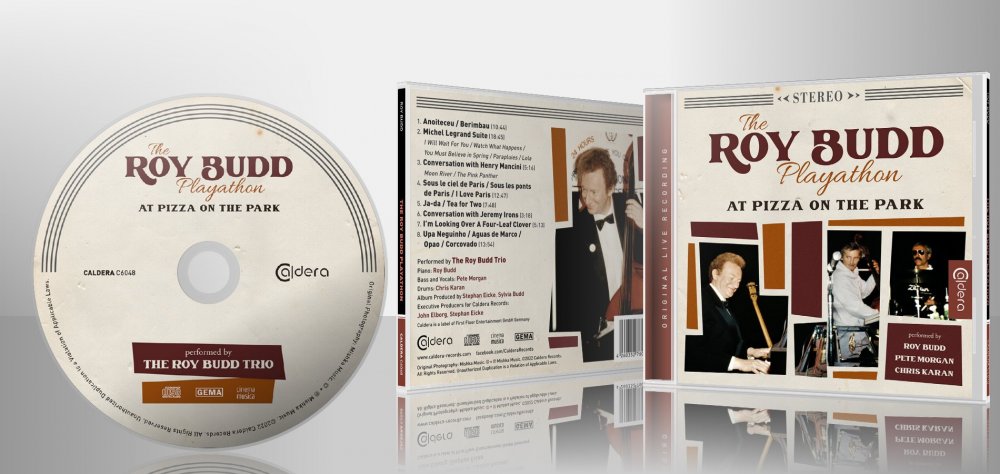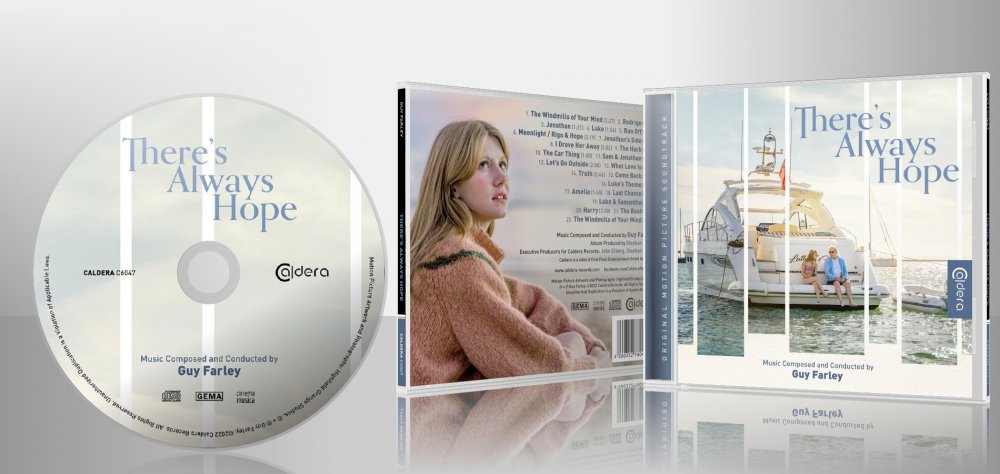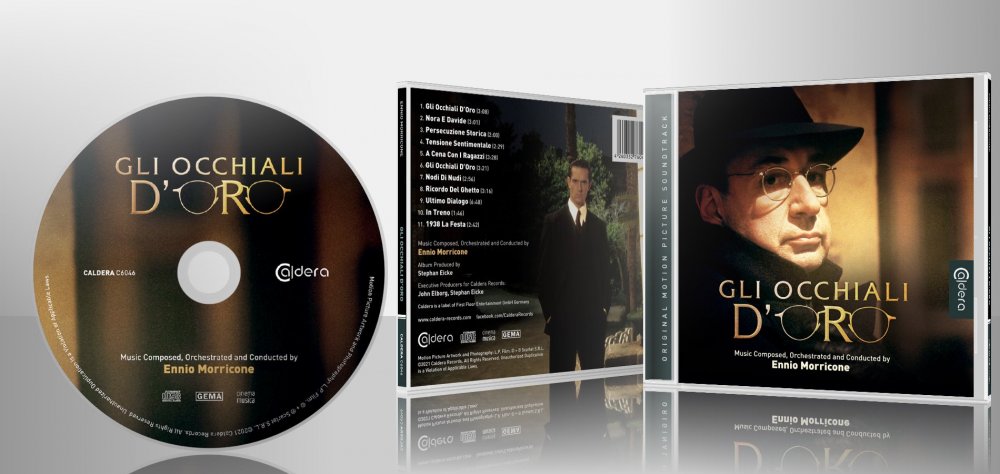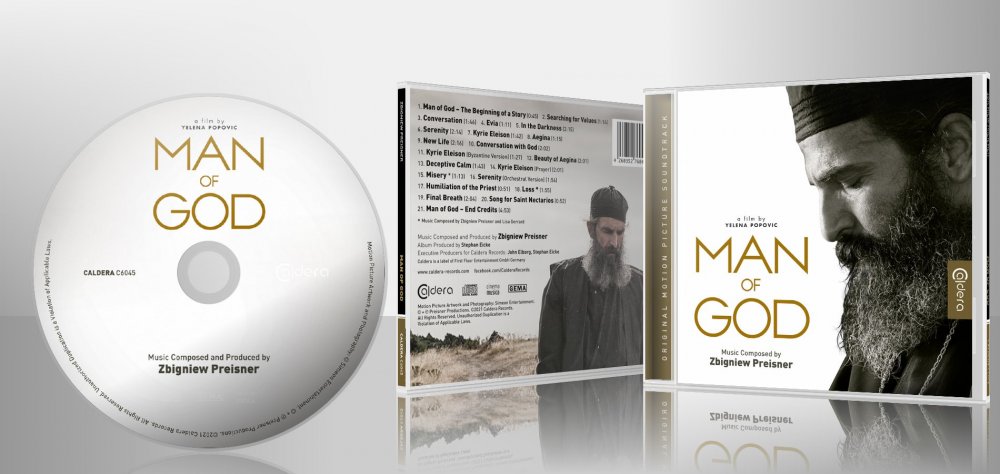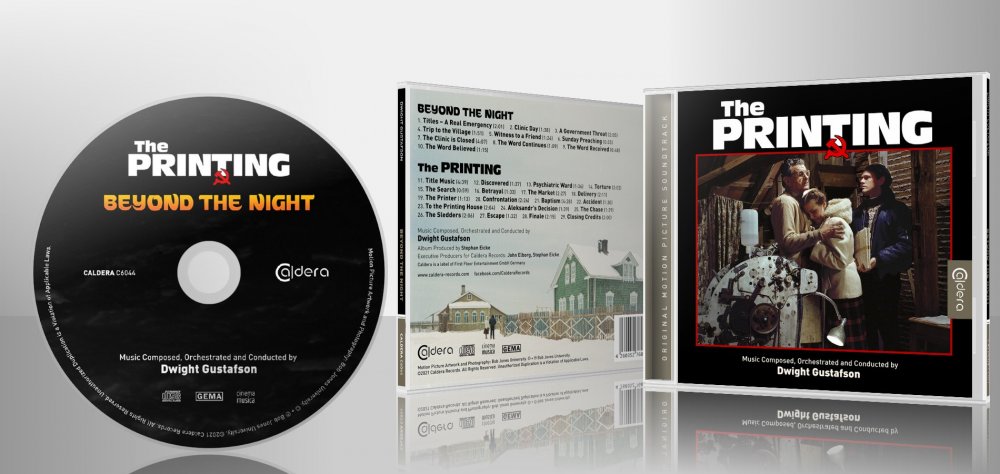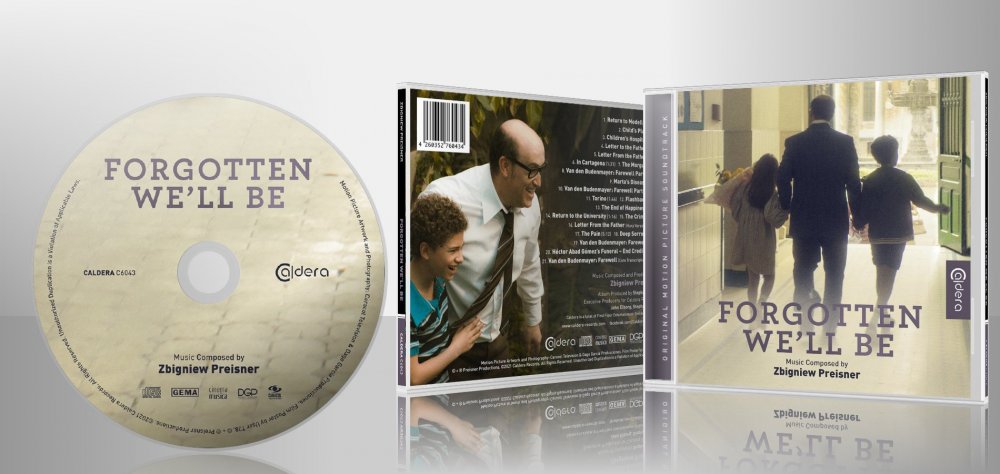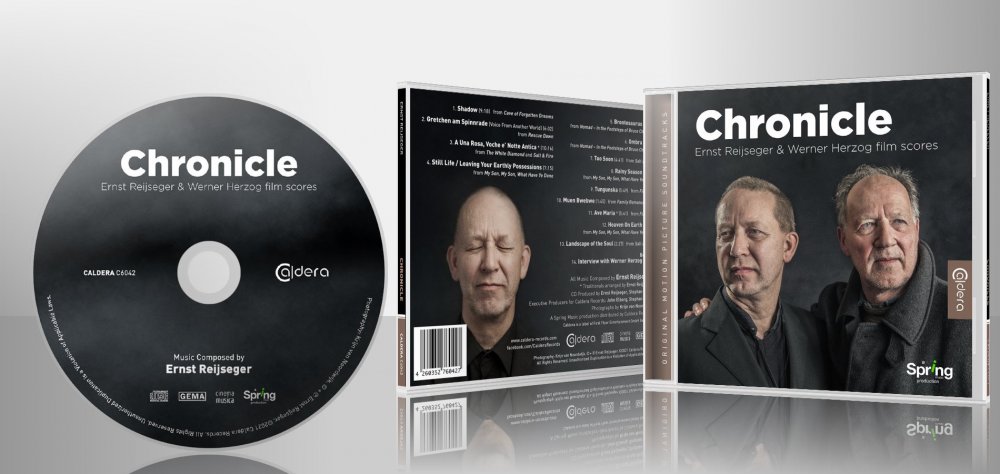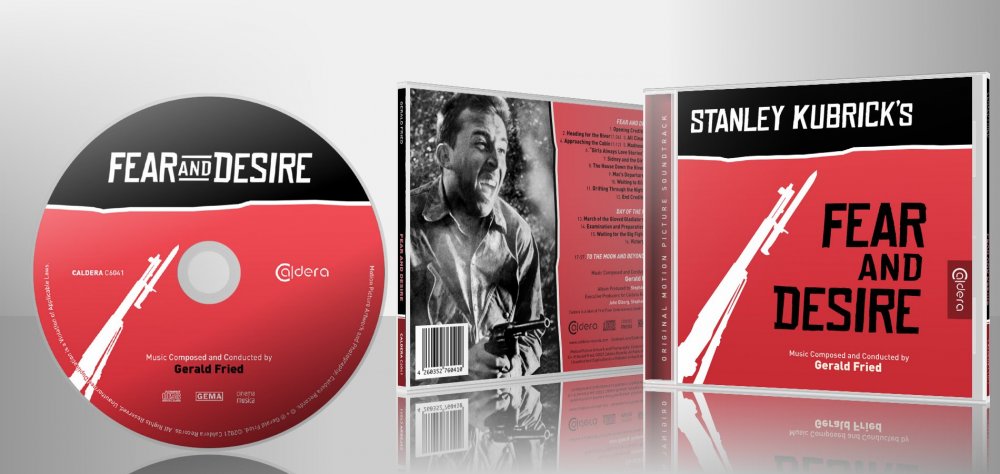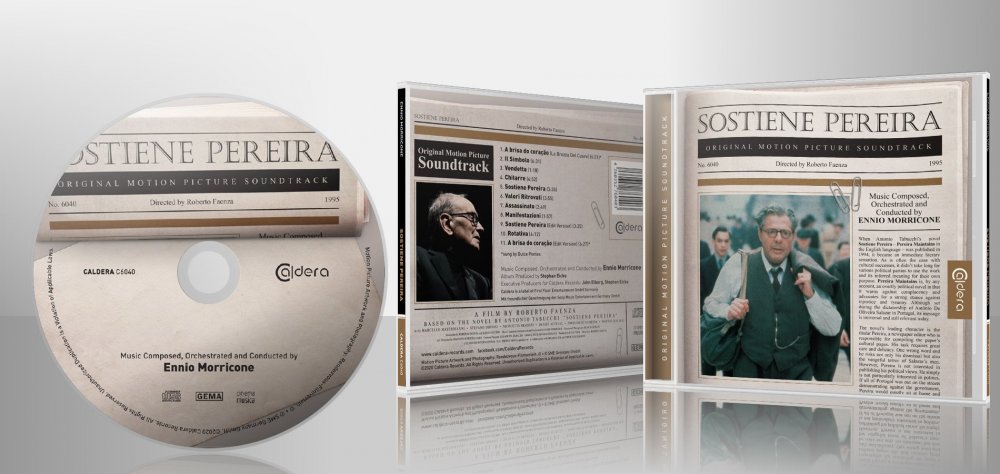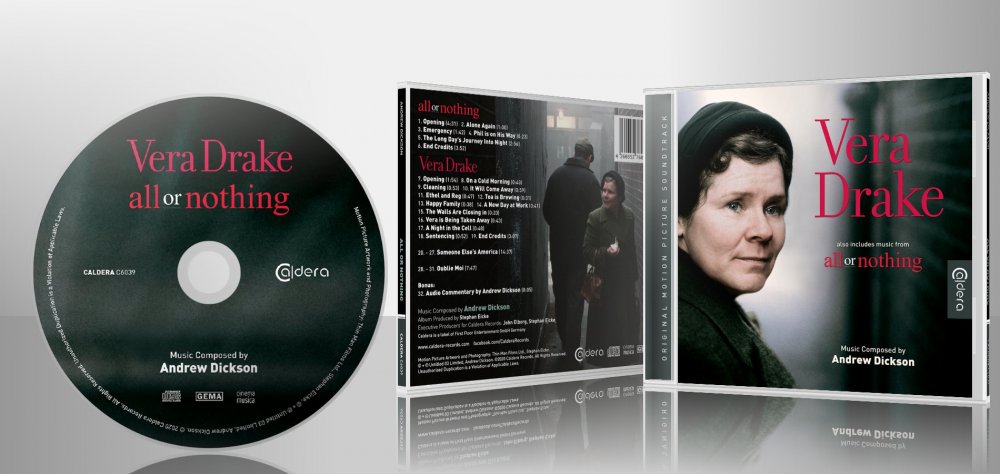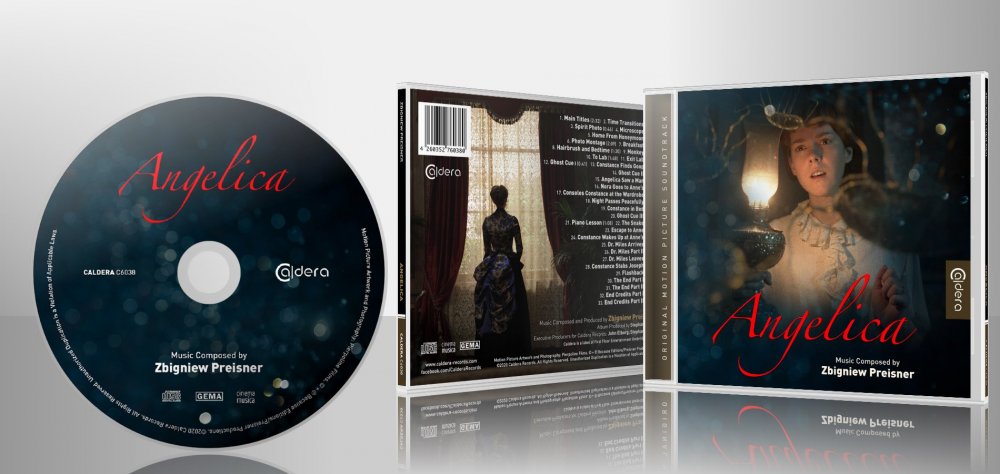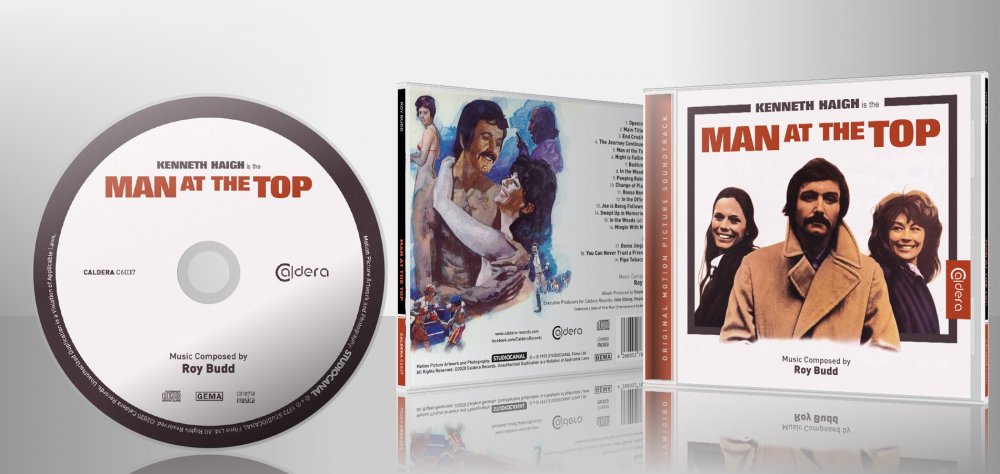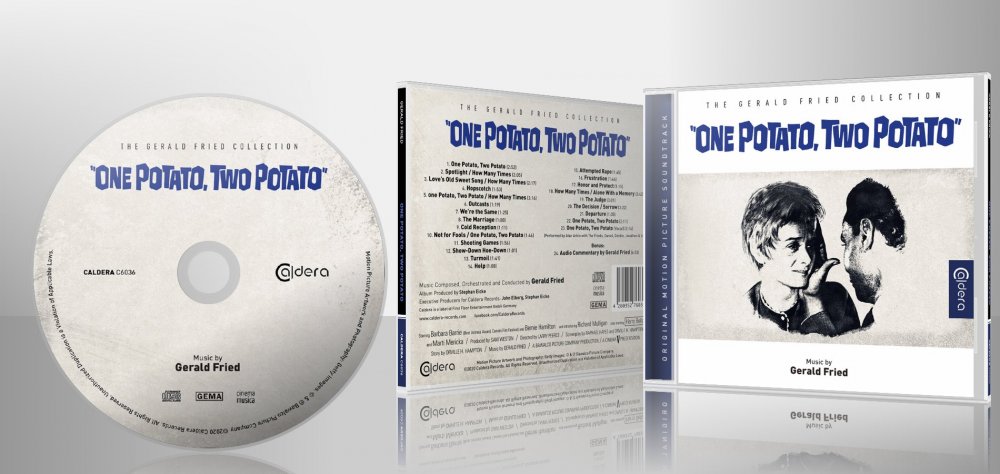-
Gesamte Inhalte
81 -
Benutzer seit
-
Letzter Besuch
Alle Inhalte von Caldera
-

veröffentlichung Caldera: THE ROY BUDD PLAYATHON (Roy Budd)
Caldera erstellte ein Thema in Scores & Veröffentlichungen
C6048 Caldera Records is proud to present “The Roy Budd Playathon”, a previously unpublished selection of a legendary jazz marathon featuring Roy Budd, drummer Chris Karan and bass player Pete Morgan. In 1989, the trio played a 24 hour Playathon in Knightsbridge, London. The tapes were recently recovered from Budd’s estate and showcase the composer and pianist at the height of his talent as a supremely gifted entertainer with an incomparable knack for breathing new life into standards that were especially close to his heart. In the late 80s, Budd decided to set up an Anti-Drug Abuse Foundation (ADA) after he had seen close friends of his get addicted to crack and other substances. In order to collect funds, he and his colleagues Pete Morgan and Chris Karan staged a 24 hour jazz marathon in London. While playing feverishly, they took calls from friends and supporters such as Henry Mancini, Dudley Moore, Jeremy Irons and George Fenton. Roy Budd was at the time in the throes of depression. On top of his psychological problems came physical ones: throughout the Playathon, Budd was under constant, strict observation of a French doctor who had to give him multiple back injections due to severe pain. Over the course of the 24 hours, Budd also complained of nose bleed several times. His pain is never evident in his music: the performance of his trio is one of unbridled joy. In close collaboration with Sylvia Budd, we decided to release a selection of the concert on disc. Choosing the numbers was challenging: Budd, Morgan and Karan had repeated only a few standards. Since they didn’t want to repeat themselves, it left us with roughly 280 untitled pieces that we could choose from. We decided to put a varied selection on this CD: film music (the Legrand suite), French chansons (“Sous le ciel de Paris”), Brazilian songs (“Aguas de marco” by Jobim of which Budd was a great admirer and personal friend), standards (“Tea for Two”), and two conversations between Budd and celebrities Henry Mancini and Jeremy Irons to fully capture the mood and diversity of the Playathon. The 48th CD-release of Caldera Records features a detailed booklet-text by Stephan Eicke and elegant artwork by Luis Miguel Rojas. The CD was mastered by Richard Moore and produced by Stephan Eicke and John Elborg. Music Performed by Roy Budd, Chris Karan and Pete Morgan Album Produced by Stephan Eicke Executive Producers for Caldera Records: John Elborg, Stephan Eicke The Roy Budd Playathon 1. Anoiteceu/Berimbau (10:44) 2. Michel Legrand Suite (18:45) I Will Wait For You/Watch What Happens/You Must Believe in Spring/Parapluies/Lola 3. Conversation with Henry Mancini (5:16) Moon River/The Pink Panther 4. Sous le ciel de Paris/Sous les ponts de Paris/I Love Paris (12:47) 5. Ja-da/Tea for Two (7:48) 6. Conversation with Jeremy Irons (3:18) 7. I’m Looking Over A Four-Leaf Clover (5:13) 8. Upa Neguinho/Aguas de marco/Opao/Corcovado (13:54) For more information and sound clips, please visit: http://caldera-records.com/portfolio/the-roy-budd-playathon/ -

Caldera: THERE IS ALWAYS HOPE (Guy Farley)
Caldera erstellte ein Thema in Scores & Veröffentlichungen
C6047 Caldera Records is proud to present Guy Farley’s score for the motion picture “There’s Always Hope”, directed by Tim Lewiston. The drama tells the story of Hope and her parents who split up after her father – Jonathan, played by Colm Meaney – discovers his wife has had an affair with a colleague, smarmy Luke. In her youthful naivety, Hope refuses to accept the termination of her parents’ relationship and makes it her mission to fix it. She does so by joining her father in his holiday home in Portugal to which he has fled. There, she starts playing the good fairy as if in a Shakespearean play. Can she succeed? Director Tim Lewiston had already worked with composer Guy Farley on his directorial debut “The Hot Potato”. Ten years later, they reconnected when Lewiston set out to make his next film. For the composer, it was a dream project, also because he was encouraged to channel some of his musical heroes. In this case, Michel Legrand was an inspiration as Lewiston asked Farley to re-record the classic “The Windmills of Your Mind” from “The Thomas Crown Affair”. But his rich score has much more to offer besides an elegant new rendition of a legendary hit: Freed from the shackles of temp-tracks, Farley developed several themes for the different characters in the film. Chords and inflections from “The Windmills of Your Mind” found their way into the underscore – subliminally, as Farley later noticed when he listened back to his score. Legrand’s suave string-writing is noticeable, for instance, in “Jonathan”, which also introduces Jonathan’s theme. In its elegance and finesse, it perfectly captures the protagonist’s character, the intellectual, often melancholic writer. Hope’s theme is derived from Jonathan’s theme, sweet and old-fashioned, equally gentle and elegant – and remarkably different from Luke’s theme, the leitmotif for Sam’s affair who serves as the antagonist in the film. Recorded at Abbey Road Studios, “There’s Always Hope” is one of Guy Farley’s most refined, elegant scores, and we could not be prouder to offer it on CD. The 47th CD-release of Caldera Records features a detailed booklet-text by Stephan Eicke and elegant artwork by Luis Miguel Rojas. The CD was mastered by Richard Moore and produced by Stephan Eicke and John Elborg. Music Composed and Conducted by Guy Farley Album Produced by Stephan Eicke Executive Producers for Caldera Records: John Elborg, Stephan Eicke For more information and sound clips, please visit: http://caldera-records.com/portfolio/theres-always-hope/gallery/soundtracks/ There’s Always Hope 1. The Windmills of Your Mind (2:27) 2. Rodrigo (1:57) 3. Jonathan (1:21) 4. Luke (1:54) 5. Run Off (3:10) 6. Moonlight/Rigo & Hope (2:19) 7. Jonathan’s Side (4:09) 8. I Drove Her Away (2:02) 9. The Hack (1:08) 10. The Car Thing (1:08) 11. Sam & Jonathan (0:55) 12. Let’s Go Outside (2:08) 13. What Love is (1:20) 14. Truth (2:46) 15. Come Back (1:27) 16. Luke’s Theme (1:06) 17. Amelia (1:45) 18. Last Chance (1:02) 19. Luke And Samantha (1:44) 20. Harry (2:00) 21. The Boat (1:55) 22. The Windmills of Your Mind (2:14)-
- soundtrack
- score
-
(und 2 weitere)
Markiert mit:
-
Guten Tag. Wir haben mal ein bisschen Frühjahrsputz gemacht und ausgewählte Titel in limitierter Stückzahl zum Verkauf gestellt - jeweils für 10 € für Caldera, Versand inklusive, originalverpackt. Vielleicht findet ihr ja was Hübsches. Hier ist unser neuester Titel, über den ihr auch zu unserem Schop gelangt. https://www.ebay.de/itm/165437716885
-
Hier ist ein kurzer Auszug aus meinem Buch, "The Struggle Behind the Soundtrack", der etwas mehr in die Tiefe geht: The days are long gone when one director or one producer was in charge of musical decisions. Now there are countless different producers and decision-makers who attempt to guarantee that a movie, with all its ingredients, is marketable. As Bruce Broughton puts it: “In the last few years, they have wanted it fast and cheap. Because of the schedules and all the silly previews, they make the composer rewrite cues several times for no reason at all. This has made it economically difficult for composers and nearly impossible to work on their own. Today, I would go home, start to write and then I would have to put it into the synthesizer. Somebody would then send the file to the producers or director and I would have to wait for their notes. Then I would send the new file of rewritten cues and they would send their new notes. I'd be working endlessly just to get ten minutes of music done. I would need somebody else to help. Nobody is on salary nowadays and very few are getting a fee. They are working from a 'package'. They get a music budget to pay for all the expenses themselves. Some guys do very well with that. Others are terrible with that. It is a very difficult time. I don't think it is a happy time.” Producers and directors expect the composer to work as quickly as the quickest person in town, never mind how many assistants it is necessary to employ to get the job done. This increased pressure in the industry has lead composers who value working on their own, rather than relying on a team of arrangers, interns, assistants and orchestrators, to reject offers that would require them to work as the head of a team to get the job done in time. As Rachel Portman admits: “It is really sad – or not. It probably isn't when you are a young composer trying to get in. I think it can help them if they get a break. It's not something I am interested in doing, really. I have been quite purist about it. When I have been offered projects where I know I would have to have a number two composer underneath me for me to do it, I turn them down. I want to write music that is bespoke. All of it. When I did Used People and Benny and Joon I orchestrated every note of it. I loved it. I am not interested in handing things over. That's not me.” Bruce Broughton recounts a rather amusing anecdote about a director's expectations: “Years ago, a director came over to my house. At that time I had a piano in the room where I was working. I had some synthesizers in another room. He came into my piano room, looked around and said, 'Is this your stuff?' I said, 'My stuff? Yes, this is what I write on.' Then I understood what he was talking about. He expected to come in and see what a lot of composers were getting in these days, all the hardware. So I had to show him 'my stuff'. Well, I have now heard: 'Where is your team?' They expect you to show up with other people. If you just come up with yourself that's very old-fashioned. Do you still write with a pencil? Do you ride on a horse and buggy? Do you have color photographs or just black and white? They expect you to have a team. Everybody has their team.” Are most directors and producers aware of the fact that the composer they commission works in a team rather than writing everything themselves? Not necessarily, as one composer and arranger, who wishes to remain anonymous, says: “I don't think many producers and directors know about the extent of composers farming out work. Composers make sure that their clients never interface with the people who are actually writing the music. Especially in the context of television series, producers must be aware that the composer they are hiring is already working on five or six other shows. It's easy to look up that information on IMDb. Yet, they seem to be convinced that the composer alone is going to have enough time to address their every need, while simultaneously working on five other shows and maybe also on two features and a video game. Occasionally, you hear a story of a director asking a composer to not employ ghostwriters on a specific project, but that seems to be rare. In most cases, composers are scared of their clients finding out that someone else has been writing their music, and the arrangers are scared of telling the truth, in fear of never again finding work in an industry that will shun them.” Yet Broughton argues that today's producers are more ready to accept the idea that they also hire the composer's team when they hire a composer. “They may not think about what the team does though. What the team does varies from composer to composer. What happens as well is that after you presented the score, the producers or director decide to use the score in a completely different manner and they rearrange the whole score on the stage. Is that ghostwriting? As a composer, you can never be sure how your score gets into the film. I'm under the impression that people are now used to seeing the composers' team. You walk on the stage and you have at least an orchestrator there, likely a technician running clicks, likely some software or hardware programmer. There are video monitors everywhere, running all kinds of software all at once. It's obvious that the composer is coming in with a team. Who did what, I don't know. The producers and directors care about the name of the person they hired.” Matthew Margeson has had a slightly different experience as a composer in Hollywood, which leads him to assume that producers and directors are now very well aware of the fact that only few A-list composers in town are writing everything themselves: “Especially in the studio system no one is oblivious to that any more. Directors and the heads of the studios know that it's a team effort and that there are maybe some young composers that are just trying to make their way. It's a beautiful thing because it's giving a lot of young people a chance, and because everyone is aware that it happens maybe the need from the composers perspective to hide isn't as great as it once was.” Yet the revelation that a composer's work was partially written by ghostwriters may not only anger directors and producers, it can also be disillusioning for young composers who grew up as fans of film music. Admits John Ottman: “The whole factory mentality is still weird to me. When I first started I was like, 'Wow, how can a composer go into a meeting and people know that other people are writing for him?' Now people just know it and they accept it. As a composer you are now seen as sort of a director. They are basically an architect or a contractor who has his workers around. We know when that whole factory mentality started. It was just so in the face that everybody just accepted it. To me it's still weird. But I'm an old fart. Now it's necessary for composers. Even if it's just a few cues, you got to have some help.” [...] Ghostwriter are always at the mercy of their employer. Whether an arranger/ghostwriter will receive credit or royalties depends on several factors, as John Ottman explains how he approaches paying his staff: “Everyone is treated the same. But I don't have a massive team. It all comes down to the project, whether I am paid well or not, and how much I am paying this person as well. I feel horrible subjecting anybody to writing ghost music. I know how agonizing it is to write music. I almost feel terrible when asking anyone to do it. I pay really well upfront because I feel bad. Then I put them through hell. I don't think any writer writes a cue for me less than ten times, sometimes more than that. So I pay them a lot because of the hell I put them through. It really depends on the project. Then I treat everyone the same. On Non-Stop, Edwin Wendler wrote a lot. That was a different situation. When I work with people, they do a couple of cues. But Edwin wrote the music for a couple of reels because I was busy doing Days of Future Past. I had written three reels of Non-Stop before I had to go to Montreal, so Edwin worked with me on a couple of reels. I am not going to hide it that someone helps me out so much.” Matthew Margeson makes the payment for his arrangers and ghostwriters dependent on the actual work they contribute, something which differs from project to project. As he elaborates: “I like to keep it a very static system. If I have written a piece of music, fully orchestrated it myself and I then get an updated version of the film three weeks later where they removed 30 seconds of that scene, I won't have time to adjust that music accordingly. So I may have someone come to my studio in the middle of the night and remove that 30 seconds and musically connect the tissue, so it still sounds like a piece of music. That may be a lightly less of a creative job than me sketching out a piece and having someone else orchestrate it. I take all this in consideration when giving out the royalties. […] There are definitely composers that I worked for who will say, 'This is something that I can't give any royalties out for,' or, 'I need you to do this under the radar.' I think that in some cases, in their defense, that may be it's the first time they work for a specific studio or a director and they do want to keep that relationship with that director close and not let them through the smoke and mirrors completely.” [...] The set-up of Hans Zimmer's studios is explained by Matthew Margeson who started his career with Zimmer before venturing out on his own and writing the music for productions such as Eddie the Eagle and Kingsman: The Golden Circle: “When I was working for guys like Klaus [Badelt] and Jim Dooley, it was just an employer/employee relationship. I was brought on and paid as an assistant. As long as you didn't mess up too bad and you got the job done in time you were welcome to stay. In a lot of the composers' suites, not only at Remote Control, there is maybe a writing room for the composer and then an assistants' room which may have a smaller set up in it, or a place for you to do administrative tasks. But then of course when the composer leaves at the end of the day, that's a lot of the time when my job would start. I would then go into the writing suite and clean up what he was doing as far as backing up things, or finishing arrangements, or uploading a finished cue to the server, or emailing it to a director, or doing the preparations for the next day.” When working with a team on a film score it is essential to make each piece of music fit homogeneously into the overall sound of the score, rather than having a mixture of styles and different approaches by the various composers contributing to the project. Nothing is more irritating than a patchwork score which actually sounds like a patchwork. The approach to resolving this potential problem is elaborate, as explained by C., a former assistant at Remote Control who wishes to remain anonymous. At the beginning of each project, Zimmer has a meeting not only with the director of the movie and perhaps some of the producers, but also with the composers who will contribute to the score, as well as a music editor and possibly some assistants – a group of not more than ten to fifteen people overall: “In a production meeting, the division of work is being scheduled. As a composer, after you return from the meeting and go back into your studio, there are already several messages on your computer with detailed notes about the production which was just talked about a few minutes ago. The work flow is absolutely amazing and necessary. It is incredibly quick and one meeting is not enough for that.” Indeed, in the course of the production of the score for a movie there will be several meetings at regular intervals, as C. continues: “Even when Hans is mentioned as the main composer on a project, the director talks to all composers involved in the team during a production meeting. As the music is being presented in a meeting this makes sense. At the end of a production such a meeting is likely to be held every day, or at least every other day. Sometimes Hans asks a question during the meetings and sometimes you do better not to answer. Because sometimes he just wants to have your skills proofed.” The amount of music Zimmer writes himself varies from film to film, but the process itself is always the same, with Zimmer exploring new, unusual sounds as the composer explained: “Before writing a single note, my team and I spend a lot of time programming new sounds, sampling new instruments. [...] The moment I start writing, I start mixing. Since I don't write on paper, I spend a long time making each note and sound convey the right emotion. It helps later with the live musicians. I can be very specific in my language (and I use English, not Italian) to convey to them why I want a note or phrase played a certain way. I don't make changes on the scoring stage, I don't let directors make changes with the musicians there. The recording is about getting a performance, not re-writing the cue. Nothing sounds worse than a bunch of bored musicians that had to wait while someone's changed an arrangement.” After programming new sounds Zimmer writes a suite of music for the movie. C. elaborates: “This suite is based on his talks with the director and the musical ideas he got from them. The vision is his. Of course, he asks for opinions from people at Remote Control, but the overall concept is his and his alone. Some composers who worked for Hans were not able to deal with the stress. You can't solve problems with logic. You need to solve them psychologically to be able to survive there.” After each production meeting the composers who have been assigned to write parts of the score retreat to their individual studios and work on their cues, which are based on the themes by Zimmer. To be able to work as efficiently as possible in a team, Remote Control has its own internal server. During the night, everything that had been written during the day is synced to all the computers so that every composer has the same data available when they come into the studio the next morning. Every composer not only has all the music written by every other composer, but also has all the materials created, such as virtual instruments and samples. There are people working at Remote Control whose job is to build virtual instruments, manage the samples and ensure this content is available to the composers. With this way of working, every new production has a set of new sounds, ensuring that each project is distinctive. As elaborate as this technology is, it can cause problems, as recounted by C. in a rather amusing anecdote: “One night, I was in charge of the back up. But I needed some material from the computer which I wanted to put on my private hard drive. I put my hard drive in and pulled it out again afterward. Or I thought it had been my hard drive. As soon as I had pulled it out, an error message of the sync software appeared on my computer, saying that the back up could not be completed. I looked at other computers in the studio as well and found that the message appeared on every single one of them. I had pulled out the wrong drive! This meant that every computer had a different amount of material. I panicked. I then had to do a night shift to repair the damage by walking into every studio and checking every computer to see what the individual status was and if any material had been damaged.” The Struggle Behind the Soundtrack - Amazon
-

Caldera: GLI OCCHIALI D'ORO (Ennio Morricone)
Caldera erstellte ein Thema in Scores & Veröffentlichungen
C4046 Caldera Records is proud to present Ennio Morricone’s score for the motion picture “Gli occhiali d’oro”, directed by Giuliano Montaldo. Giuliano Montaldo’s adaptation of Giorgio Bassani’s novel tells several stories at once. The title – “Gli occhiali d’oro” (“The Gold Rimmed Glasses”) – was carefully and intelligently chosen. The over-arching subject is, after all, blindness. Or seeing, depending on how one chooses to look at it. One storyline concerns a doctor (played by Philippe Noiret) who is respected as long as he hides his homosexuality. Another deals with a young Jewish man (played by Rupert Everett) who recognises the threats Mussolini and Hitler pose in the Italy of the 30s. Against these stories of individuals, is one of communal blindness, of intelligent, educated and sensible citizens being lured by fascism. At another level, “Gli occhiali d’oro” is a scathing critique of the hypocrisy of the upper classes, in which everybody lives behind a facade to uphold their reputation and standing. Though now difficult to find, Giuliano Montaldo’s “Gli occhiali d’oro” was revered by critics when it came out in 1987. It won the David di Donatello Award for Best Music. The whole score is one of Morricone’s most carefully crafted, a tender composition that not only manages to capture the grim atmosphere of the film, its dread and sorrow, but also enhances it, encapsulating the painful loneliness felt by its two protagonists. “Gli occhiali d’oro” is comprised of several themes: the main theme, which plays over the opening credits; the love theme for David and Nora; the comparatively upbeat “A Cena Con I Ragazzi”, the forlorn and trepidatious “Persecuzione Storica”; and the yearning and desolate “Ricordo Del Ghetto”. Claudio Fuiano had prepared an LP programme of the score for “Gli occhiali d’oro” under Ennio Morricone’s supervision for the film’s release. However, the album was not issued until the 90s, by Screen Trax on CD. We use the same programme, remastered by Richard Moore. The score is not complete, since already by the 90s the original, complete tapes could not be located. We are delighted to finally make “Gli occhiali d’oro” available again and sincerely thank Claudio Fuiano for his kind and generous support. The 46th CD-release of Caldera Records features a detailed booklet-text by Stephan Eicke and elegant artwork by Luis Miguel Rojas. The CD was mastered by Richard Moore and produced by Stephan Eicke and John Elborg. Music Composed , Orchestrated and Conducted by Ennio Morricone Album Produced by Stephan Eicke Executive Producers for Caldera Records: John Elborg, Stephan Eicke 1. Gli Occhiali D’Oro (3:08) 2. Nora E Davide (3:01) 3. Persecuzione Storica (2:00) 4. Tensione Sentimentale (2:29) 5. A Cena Con I Ragazzi (3:28) 6. Gli Occhiali D’Oro (3:21) 7. Nodi Di Nudi (2:56) 8. Ricordo Del Ghetto (3:16) 9. Ultimo Dialogo (6:48) 10. In Treno (1:46) 11. 1938 La Festa (2:42) For more information and sound clips, please visit: http://caldera-records.com/portfolio/gli-occhiali-doro/- 1 Antwort
-
- ennio morricone
- giuliano montaldo
- (und 4 weitere)
-
C6045 Caldera Records is proud to present Zbigniew Preisner’s score for the motion picture “Man of God” from 2021, directed by Yelena Popovic. Popovic’s biopic chronicles the most turbulent years in the life of a man who had made it his mission to serve others and improve the conditions of those in need: Saint Nektarios. Popovic’s film shows how Nektarios helps the poor and destitute, provoking three objectors within the church turn to the bishop’s patriarch Sophronios. No longer wiling to hide their anger at Nektario’s servitude towards sinners and harlots, his enemies claim he will bankrupt the church and usurp the patriarchy. Without trial, Nektarios is convicted and exiled from Egypt in 1891. Particularly because of his deep love for Greece, its culture and people, Zbigniew Preisner was delighted to score “Man of God” – and agreed to do so without having read the script. From the beginning, it was clear to Preisner he wanted to use a choir – a Byzantine one. After some searching, he collaborated with the Choir of Chanters, “The Maestros of the Psaltic Art” (?? ?a?st??e? t?? ?a?t???? ??????), one of the most famous Byzantine Choirs. Following their collaboration of “Valley of Shadows”, Zbigniew Preisner and Lisa Gerrard worked together again. The latter recorded her sung parts – written by her – in Australia. Furthermore, Preisner felt it the right choice to use Greek instruments. It was obvious and necessary for a film about a Greek saint. The local color is provided by a qanun, a string instrument not dissimilar to the zither and often associated with Greece and its culture. “Man of God” is also notable for its mix of symphonic and electronic music, used to achieve spiritual metaphysics. “Man of God” is one of Zbigniew Preisner’s richest scores, a unique exploration of symphonic music infused with local, Greek, colour, electronics and Byzantine elements, particularly in the employment of Lisa Gerrard’s special talent, used to powerful effect. The 45th CD-release of Caldera Records features a detailed booklet-text by Stephan Eicke and elegant artwork by Luis Miguel Rojas. The CD was mastered by Leszek Kaminski and produced by Stephan Eicke and John Elborg. Music Composed by Zbigniew Preisner Album Produced by Stephan Eicke Executive Producers for Caldera Records: John Elborg, Stephan Eicke 1. Man of God – The Beginning of a Story (0:45) 2. Searching for Values (1:14) 3. Conversation (1:46) 4. Evia (1:11) 5. In the Darkness (2:15) 6. Serenity (2:14) 7. Kyrie Eleison (1:42) 8. Aegina (1:15) 9. New Life (2:16) 10. Conversation of God (2:02) 11. Kyrie Eleison (Byzantine Version) (1:27) 12. Beauty of Aegina (2:01) 13. Deceptive Calm (1:43) 14. Kyrie Eleison (Prayer) (2:01) 15. Misery (1:33)* 16. Serenity (Orchestral Version) (1:54) 17. Humiliation of the Priest (0:51) 18. Loss (1:55)* 19. Final Breath (2:04) 20. Song for Saint Nectarios (0:52) 21. Man of God – End Credits (4:53) *Music Composed by Zbigniew Preisner and Lisa Gerrard For more information, and to listen to sound clips, please visit our homepage: http://caldera-records.com/portfolio/man-of-god/
-
- 1
-

-
- zbigniew preisner
- nektarios
-
(und 5 weitere)
Markiert mit:
-

Die Vorankündigungs-Veröffentlichungs-und-Gerüchte-Küche (Teil 2)
Caldera antwortete auf Marcus Stöhrs Thema in Scores & Veröffentlichungen
Caldera-CDs kaufen. -

Caldera: BEYOND THE NIGHT/THE PRINTING (Dwight Gustafson)
Caldera erstellte ein Thema in Scores & Veröffentlichungen
C6044 Caldera Records is proud to present Dwight Gustafson’s scores for the motion pictures “The Printing” and “Beyond the Night”, directed by Tim Rogers and Katherine Stenholm respectively. “Beyond the Night”, from 1983, tells the story of John and Bettie Dreisbach, passionate missionaries who first worked in Nigeria tending to leprosy patients and spreading the word of Christ in an area that was nearly exclusively Muslim. For close to ten years, the Dreisbachs served as ministers in the Sahara, before the government forced them to leave. “Beyond the Night” describes the couple’s time in the Sahara Desert. Dwight Gustafson’s themes are infused with discreet elements from African music such as the rhythmic drumming in the “Titles”, specific tone sequences particularly popular in Northern African music (“Trip to the Village”) and a heavy use of grace notes in the woodwinds (“Clinic Day”). What binds the score together is Gustafson’s strong main theme, first heard in the “Titles” and later through diverse variations heard in the course of the movie/score. In its sweeping nature, the theme has a folkloric Americana quality that echoes the works of Aaron Copland and even the spiritual compositions of Alan Hovhaness. “The Printing” tells the story of hardship experienced by Christians in the cause of their faith. This time, the story is set in the Soviet Union and celebrates Christian believes who, despite being threatened by the communist government which had made it its mission to stifle Christian belief, dared to openly worship the Lord. Not only do the heroes of this film refuse to abandon Christ, but they continue to secretly print Bibles, convinced that God will protect them from the evil schemes of the communists. Gustafson’s music here is as moody and gray as the architecture of communist-era Russia – where incidentally, the composer can also be seen in the film, playing a pastor. Unusually for him, he utilizes a synthesizer and subtle suspensions to introduce his main theme, a downbeat yet still lyrical melody in a minor key that later blossoms through variations that the composer develops during the course of the score. His delicate, sophisticated orchestration remains evident throughout. The 44th CD-release of Caldera Records – a world premiere – features a detailed booklet-text by Stephan Eicke and elegant artwork by Luis Miguel Rojas. The CD was mastered by Richard Moore and produced by Stephan Eicke and John Elborg. Music Composed and Conducted by Dwight Gustafson Album Produced by Stephan Eicke Executive Producers for Caldera Records: John Elborg, Stephan Eicke Beyond the Night 1. Titles – A Real Emergency (2:01) 2. Clinic Day (1:38) 3. A Government Threat (2:05) 4. Trip to the Village (1:51) 5. Witness to a Friend (1:24) 6. Sunday Preaching (0:35) 7. The Clinic is Closed (4:07) 8. The Word Continues (1:09) 9. The Word Received (0:48) 10. The Word Believed (1:15) The Printing 11. Title Music (4:39) 12. Discovered (1:37) 13. Psychiatric Ward (1:36) 14. Torture (2:02) 15. The Search (0:59) 16. Betrayal (1:33) 17. The Market (2:27) 18. Delivery (2:11) 19. The Printer (1:13) 20. Confrontation (2:26) 21. Baptism (4:28) 22. Accident (1:30) 23. To the Printing House (2:04) 24. Aleksandr’s Decision (1:39) 25. The Chase (1:39) 26. The Sledders (2:06) 27. Escape (1:32) 28. Finale (2:15) 29. Closing Credits (2:00) For more information and sound clips, please visit our homepage: www.caldera-records.com/portfolio/the-printingbeyond-the-night/-
- gustafson
- soundtrack
- (und 7 weitere)
-

Caldera: FORGOTTEN WE'LL BE (Zbigniew Preisner)
Caldera erstellte ein Thema in Scores & Veröffentlichungen
C6043 Caldera Records is proud to present Zbigniew Preisner’s score for the motion picture “Forgotten We’ll Be” from 2020, directed by Fernando Trueba. Trueba’s acclaimed film is inspired by Héctor Abad Faciolince’s memoir “Oblivion: A Memoir” in which he describes with great tenderness the life and work of his father, the revered Colombian scientist and activist Hector Abad Gómez who was killed by mercenaries in 1987. Adapted by Trueba’s brother David, the film focuses on two major time periods: the 70s and mid-80s. While the latter part – shot in black and white – mainly deals with Gómez’ political agenda and achievements, the scenes set in the 70s – shot in color – paint Gómez as a devoted family man. They also describe the turmoil experienced by him and his family through the hands of his young son Hector who runs over a woman in his car and throws stones through the window of a Jewish family’s home. After their collaboration on “The Queen of Spain”, “Forgotten We’ll Be” marked a new collaboration between the revered director and renowned composer Zbigniew Preisner. “Forgotten We’ll Be” is similar to other Preisner scores released by us at Caldera Records – namely “Valley of Shadows” and “Lost and Love” in that childhood and the loss of childhood innocence play a pivotal role. “Valley of Shadows” and “Forgotten We’ll Be” are even partly told from a child’s point of view. Hence there was no question that Preisner’s score for Fernando Trueba’s most recent film should capture themes of childhood musically. Hence, the composer devised gentle and yet poignant themes for orchestra, choir and solo instruments such as the harp which features prominently in one of Zbigniew Preisner’s most haunting and touching scores. The 43rd CD-release of Caldera Records – a world premiere – features a detailed booklet-text by Stephan Eicke and elegant artwork by Luis Miguel Rojas. The CD was mastered by Leszek Kaminski and produced by Stephan Eicke and John Elborg. Music Composed by Zbigniew Preisner Album Produced by Stephan Eicke Executive Producers for Caldera Records: John Elborg, Stephan Eicke Forgotten We’ll Be 1. Return to Medellín (3:22) 2. Child’s Play (0:51) 3. Children’s Hospital (1:06) 4. Letter To The Father (4:00) 5. Letter From The Father (1:59) 6. In Cartagena (1:31) 7. The Morgue (1:18) 8. Van den Budenmayer: Farewell Part I (0:41) 9. Marta’s Disease (0:24) 10. Van den Budenmayer: Farewell Part II (1:03) 11. Torino (1:44) 12. Flashback (0:46) 13. The End of Happiness (1:49) 14. Return To The University (1:16) 15. The Crime (2:35) 16. Letter From The Father (Harp Version) (1:57) 17. The Pain (5:12) 18. Deep Sorrow (1:34) 19. Van den Budenmayer: Farewell (2:18) 20. Héctor Abad Gómez’s Funeral – End Credits (2:43) 21. Van den Budenmayer: Farewell (Coro Transcription) (2:21) For more information and sound clips, please visit: http://caldera-records.com/portfolio/forgotten-well-be/-
- caldera
- soundtrack
-
(und 4 weitere)
Markiert mit:
-

Marco Beltrami & Brandon Roberts - Chaos Walking
Caldera antwortete auf horner1980s Thema in Scores & Veröffentlichungen
Da habe ich andere Sachen gehört. Marco Beltrami im Interview 2017 mit mir - teilweise in meinem Buch 'The Struggle Behind the Soundtrack' publiziert, Teile davon (bis jetzt) unveröffentlicht: "People that know me call me Darco instead of Marco so I guess I wouldn't fall in the jolly fellow category. The way I deal with an issue is by trying not to be mired in it, not to take it that seriously. I would say 30 percent of the job is enjoyable. That is the creative part, coming up with ideas and writing the music. But so much of it is not creative. It's dealing with budgets and contracts and problems, dealing with too many producers. It's the normal bullshit. It just saps your energy. By learning to remove myself a little bit from that and by saying, 'Whatever happens happens', I find that I am able to deal with it a lot better and have a more healthy relationship with my job. I feel bad for the young composer who are up and coming. They have to deal with these problems. I don't know how much longer I will do this anyway. I have other interests as well." -

Caldera: CHRONICLE - WERNER HERZOG FILM SCORES (Ernst Reijseger)
Caldera erstellte ein Thema in Scores & Veröffentlichungen
C6042 Caldera Records is proud to present "Chronicle", a celebration of the creative relationship between director Werner Herzog and composer Ernst Reijseger. For 15 years, Herzog has worked with cellist and composer Ernst Reijseger. It was he who penned the music for films as colorful as “The White Diamond”, “My Son My Son What Have Ye Done”, “Cave of Forgotten Dreams” and, most recently, “Fireball.” Ernst Reijseger is an internationally celebrated cellist. His music knows no boundaries and is therefore hard to categorize. Reijseger rejects labels such as world music despite the fact that he has worked for over a decade with Senegalese singer and poet Mola Sylla and Dutch pianist Harmen Fraanje, with Indonesian and Sardinian ensembles, accompanying their traditional folk music with skillful improvisations on his instrument that at times sounds like a didgeridoo, percussion, but rarely like a cello, so inventive his playing is. It’s unlike anything you have ever heard. "Chronicle" is a Best-of compilation that features the most remarkable recordings of Reijseger and his ensemble for some of Herzog's most acclaimed films. The 42nd CD-release of Caldera Records, released in collaboration with Spring Music Productions, features a detailed booklet-text by Stephan Eicke, an interview with Werner Herzog as a bonus track, and elegant artwork by Luis Miguel Rojas. The CD was mastered by Niels Brouwer and produced by Ernst Reijseger, Stephan Eicke and John Elborg. For more information and sound clips, please visit our homepage: http://caldera-records.com/portfolio/chronicle-ernst-reijseger-and-werner-herzog-film-scores/-
- caldera
- werner herzog
- (und 6 weitere)
-

veröffentlichung Caldera: FEAR AND DESIRE (Gerald Fried)
Caldera antwortete auf Calderas Thema in Scores & Veröffentlichungen
Juhu, ich lad' euch auf ein Eis ein. Die Auflage kommt immer auf das jeweilige Projekt an. Ich weiß gar nicht, wie viel John hier hat pressen lassen. 400, glaube ich.- 12 Antworten
-
- caldera
- gerald fried
-
(und 4 weitere)
Markiert mit:
-

veröffentlichung Caldera: FEAR AND DESIRE (Gerald Fried)
Caldera antwortete auf Calderas Thema in Scores & Veröffentlichungen
Bin ich jetzt reich?- 12 Antworten
-
- caldera
- gerald fried
-
(und 4 weitere)
Markiert mit:
-

veröffentlichung Caldera: FEAR AND DESIRE (Gerald Fried)
Caldera antwortete auf Calderas Thema in Scores & Veröffentlichungen
Ach, mutig... Mutig sind ganz andere Sachen.- 12 Antworten
-
- caldera
- gerald fried
-
(und 4 weitere)
Markiert mit:
-

veröffentlichung Caldera: FEAR AND DESIRE (Gerald Fried)
Caldera erstellte ein Thema in Scores & Veröffentlichungen
Caldera Records is proud to present Gerald Fried’s music for Stanley Kubrick’s films “Fear and Desire” and “Day of the Fight”. Gerald Fried and Stanley Kubrick became friends as teenagers. The musician enabled the latter to join a baseball team while the future director served as the conduit for Fried to join intellectual circles. They would first collaborate professionally in 1951, when Kubrick needed music for his short film, “Day of the Fight.” A year previously, the photographer had portrayed boxer Walter Cartier for Look magazine, and henceforth decided to make him the subject of a moving picture. “Day of the Fight” follows Cartier during the hours preceding a seminal fight, with the tightly focused 12-minute documentary including trivia from the boxer’s life, as narrated by Douglas Edwards. Then in 1952 Kubrick started to develop his first feature film, a drama he saw as a poetic allegory about a man lost in a hostile world. “Fear and Desire” – describing the two dominant human passions – is not to be taken literally, as it depicts the struggle of four soldiers who find themselves behind enemy lines. As opposed to opening the film with a boisterous main title fanfare (as he had done in “Day of the Fight”), he used only a solo bassoon to introduce the theme, reminiscent of Stravinsky’s famous opening of “Le Sacre du Printemps.” Kubrick loved this approach and showered his friend with compliments during the recording. Fried set out to write a profound, meaningful, touching, despairing and yet triumphant score – which he duly achieved and with which he paid tribute to the film’s qualities. Incidentally, and although he had ended their working-relationship in 1957, Kubrick was very much inspired by a film Fried worked on in 1964: “To the Moon and Beyond” was produced for the World Fair in 1964/65 in New York. The short film, narrated by “Twilight Zone” creator Rod Serling, depicted a voyage “to the moon and beyond,” showing the earth continually shrinking while the camera zooms further and further out. Because of its Kubrick connection, we included the score for “To the Moon and Beyond” here. The 41st CD-release of Caldera Records – a world premiere – features a detailed booklet-text by Stephan Eicke and elegant artwork by Luis Miguel Rojas. The CD was mastered by Richard Moore and produced by Stephan Eicke and John Elborg. Music Composed and Conducted by Gerald Fried Album Produced by Stephan Eicke Executive Producers for Caldera Records: John Elborg, Stephan Eicke Fear and Desire 1. Opening Credits (1:37) 2. Heading for the River (1:36) 3. All Clear (0:15) 4. Approaching the Cabin (1:12) 5. Madness (3:04) 6. “Girls Always Love Stories” (1:04) 7. Sidney and the Girl (2:48) 8. The House Down the River (0:13) 9. Mac’s Departure (3:43) 10. Waiting to Kill (5:04) 11. Drifting Through the Night (0:51) 12. End Credits (0:50) Day of the Fight 13. March of the Gloved Gladiators (2:48) 14. Examination and Preparation (3:53) 15. Waiting for the Big Fight (2:52) 16. Victory (0:39) 17.-27. To the Moon and Beyond (9:13) Listen to a 5 min clip here: For more information please visit: http://caldera-records.com/portfolio/fear-and-desire/- 12 Antworten
-
- 1
-

-
- caldera
- gerald fried
-
(und 4 weitere)
Markiert mit:
-

veröffentlichung Caldera: SOSTIENE PEREIRA (Ennio Morricone)
Caldera erstellte ein Thema in Scores & Veröffentlichungen
C6040 Caldera Records is proud to present Ennio Morricone’s music for Roberto Faenza’s film “Sostiene Pereira”. When Antonio Tabucchi’s novel “Sostiene Pereira – Pereira Maintains” in the English language – was published in 1994, it became an immediate literary sensation. The novel’s leading character is the titular Pereira, a newspaper editor who is responsible for compiling the paper’s cultural pages. However, Pereira is not interested in publishing his political views. If all of Portugal was out on the streets demonstrating against the government, Pereira would quietly sit at home and read a good book. He is not a supporter but an enabler. His political reluctance is challenged when he meets a young man named Rossi. Pereira’s life soon changes radically. Screenwriter and director Roberto Faenza was a perfect choice to turn the novel into a feature film. The Italian film maker had for decades depicted revolts against tyrannical governments. Here, he cast Marcello Mastroianni as the overweight editor who suffers from a heart problem. Popular French actor Daniel Auteil played Pereira’s doctor, Nicoletta Braschi (“Life is Beautiful”) and Marthe Keller (“Marathon Man”) were splendidly cast in minor roles. The director had tasked Ennio Morricone with writing music for his feature debut “Escalation” in 1967, and they had worked together ever since. By 1995, their collaboration spanned seven films, eight including “Sostiene Pereira.” The latter is one of Morricone’s most ingenious works for a Faenza film. It is intricate and subversive, subtle and stimulating. For the first time, the composer worked with Portugese singer Dulce Pontes when they recorded the song “A brisa do coração” which makes its appearance several times in the film and is presented here both in its original form and in a shorter, edited version. His score subtly features Fado, a Portugese style of music in which a woman as the singer is accompanied by one or two guitars. Morricone’s score consists of several themes and motifs the composer cleverly weaves together. “Sostiene Pereira” starts with a rhythmic pattern for wood blocks, one that recurs throughout the score and serves as its backbone before several instrumental groups consecutively join in with various motifs. The score is intricately developed in that Morricone uses all these various separate elements in other cues but in different arrangements and constellations. Ennio Morricone’s rich and vibrant score was released on CD in 1995. In collaboration with Sony Music Germany, we are proud to re-release it with detailed liner notes by Stephan Eicke, featuring Christopher Slaski’s precise transcription of the film’s main theme for study purposes. The 40th CD-release of Caldera Records also features elegant artwork by Luis Miguel Rojas. The CD was produced by Stephan Eicke and John Elborg. Music Composed and Conducted by Ennio Morricone Album Produced by Stephan Eicke Executive Producers for Caldera Records: John Elborg, Stephan Eicke 1. A brisa do coração (La Brezza Del Cuore) (6:51)* 2. Il Simbolo (6:31) 3. Vendetta (1:18) 4. Chitarre (4:52) 5. Sostiene Pereira (3:35) 6. Valori Ritrovati (3:55) 7. Assassinato (2:49) 8. Manifestazioni (1:57) 9. Sostiene Pereira (Edit Version) (3:25) 10. Rotativa (4:12) 11. A brisa do coração (Edit Version) (6:27)* *sung by Dulce Pontes For more information and sound clips please visit: www.caldera-records.com/portfolio/sostiene-pereira/ -
Bruce Kimmels Unterstellungen waren so vorhersehbar wie das Amen in der Kirche. Kimmel hatte mir nämlich kurz nach Veröffentlichung von Fried's THE BABY eine recht unhöfliche Mail geschrieben, dass man den Fried-Veröffentlichungskalender doch miteinander abstimmen sollte. Meine Antwort war, dass das aufgrund der Lizenznahme ja nicht notwendig sei. Darauf kam dann auch nichts mehr. Kimmel wollte ganz offensichtlich mehrere Frieds ohne Lizenznahmen veröffentlichen. Was Stefan sagt, ist sehr richtig. Kimmel veröffentlicht seit einigen Jahren mehr und mehr Bootlegs, weil ihm die Türen der Studios versperrt sind. Einigen schuldet er Geld, bei anderen hat er es sich mit seinem Benehmen verscherzt. Der leider viel zu früh verstorbene Nick Redman war in den letzten Jahren Kimmels einziger Fürsprecher. Selbst davor hatte Kimmel schon Bootlegs auf den Markt geworfen. Beispielsweise waren weder THE BRIDE WORE BLACK/TWISTED NERVE noch Herrmann's CHRISTMAS CAROL lizenziert laut des Herrmann Estate. Für erstere CD gabs dann (laut des Herrmann Estate) auch ein Schreiben vom Anwalt. Sowohl die Copyright-Angaben auf dem Backcover als auch die Auswahl des Bildmaterials geben schon immer gute Hinweise, ob es sich bei einer Kritzerland- oder Dragon's Domain-Veröffentlichung um ein Bootleg handelt (Bsp BRIDE WORE BLACK/TWISTED NERVE, FRIED SAMPLER, etc). Thaxton und Kimmel verwenden mit Absicht eigenes Artwork ohne film stills (beim Fried Sampler scheint ein (1) "film still" im Booklet-Inneren versteckt zu sein, wenn ich das richtig erkenne. Der Rest sind stock images.) Bzgl David Schecter: Ich habe mich in den letzten Tagen mit ihm unterhalten. Ihm wird nicht nur beim Skiles gedankt, sondern auch beim Fried Sampler: "I sometimes get thanked in CDs that I had nothing to do with, and seldom get thanked in CDs when I do help out a little (LOL!). So all I know is that I have no information about the releases you mentioned, as I had nothing whatsoever to do with them. I was asked by the label in question if I had any photos of Gerry, and I sent them some that Gerry had given me years ago. So if my name's mentioned in that Fried CD, which I don't have, that would be why. I know nothing about that score." Aus dem Soundtrackgeschäft hat David sich herausgezogen, unter anderem aufgrund der Schwemme an Bootlegs (und wegen illegaler Downloads).
-
Der Gerald Fried Sampler ist ein unlizensiertes Bootleg - wie die meisten Veröffentlichungen aus der Dragon's Domain Composer Collection-Reihe. Hier meine Anmerkungen dazu aus dem FSM Board: How does Ford A. Thaxton co-ordinate with Stephan Eicke on which Gerald Fried titles will get released ... and on whose labels? Usually that is not necessary since the right owners will tell us immediately if a score has already been licensed and is "in the works" from another label. It is, however, a pity when a label decides to put out an unlicensed score. "Survive" - which we were working on - is, of course, not owned by "Gerald Fried Productions" as the back cover claims - a company which doesn't even exist as the company registers of the different states show - but by Paramount which assigned Gerald to write a new score for the film, with publishing owned by Warner Chappell: https://www.ascap.com/repertory#ace/search/title/survive/writer/gerald%20fried Just a few days ago I had gotten in touch with the responsible licensing manager who indubitably will be surprised by this release. Unfortunately, this happened before multiple times before, e.g. with the release of Howard Blake's AMITYVILLE 3-D. Again, this is not owned by the (non-existent) Howard Blake Productions. Howard Blake's company is called Howard Blake Entertainments Limited as per the UK company register: https://find-and-update.company-information.service.gov.uk/company/08829393 But the rights to AMITYVILLE are with de Laurentiis - hence the absence of stills from the movie. (That's the reason Howard Blake had released the score previously as a promo only as is mentioned on the back cover of that CD along with Flash Gordon.) (Amusing side note: When I had lunches with Howard a few years ago, we mulled over some potential releases but the rights were always an issue. When I mentioned such-and-such was owned by such-and-such, Howard would just shrug and say, 'Who cares? Just put it out.') It's sad that these unlicensed releases kill properly licensed, official releases. So, no "Survive" from us, then.
-
Da wir umziehen und so wenig Zeugs wie möglich transportieren möchten, haben wir uns entschlossen, noch einige unserer Caldera CDs zu deutlich reduzierten Preisen anzubieten. Eingeschlossen sind unter anderem CDs von Joe Kraemer, Gabriel Yared, Zbigniew Preisner und Gerald Fried. Ran an den Speck - von den jeweiligen Titeln sind nur eine sehr begrenzte Anzahl Exemplare verfügbar - selten mehr als 4 pro Titel. In unserem eBay Shop wird man glücklich: https://www.ebay.co.uk/sch/soundtrackfreak89/m.html?_nkw=&_armrs=1&_ipg=&_from=
-
C6039 Caldera Records is proud to present Andrew Dickson’s music for Mike Leigh’s films “Vera Drake” and “All or Nothing”. “All or Nothing” tells the story of a family whose members spend their days working at essential and yet low-paid jobs. Penny, played by Lesley Manville, is the main breadwinner as a cashier in a supermarket. Her partner Phil, played by Timothy Spall, drives a cab around town after years of unemployment due to his crippling depression. Living in a council flat with their two children Rachel (Alison Garland) and Rory (a young James Corden), Penny and Phil have resigned themselves to their life on the treadmill. With his music, written for violin, viola, double bass, flute, bass flute and two guitars, Dickson chose to enhance the somewhat desolate nature of some of the characters. Although “All or Nothing” was well-received critically, it is Mike Leigh’s most underappreciated film as it stands in the shadow of the director’s next work, “Vera Drake”. Vera Drake (Imelda Staunton) is a cleaner in post-war Britain, while her husband Stan (Phil Davis) works in a garage. Although they don’t have much money, they are optimistic. Having survived – and won – the Second World War, things were looking up for the United Kingdom. The worst seemed to be behind it. However, Vera keeps a secret from their family that eventually threatens to destroy their bond. At the Venice Film Festival, “Vera Drake” won the prize for Best Film before it was nominated for eleven BAFTAs, one Golden Globe and three Oscars. While it is hailed as one of Leigh’s major works, it is also the crowning opus of Andrew Dickson’s film career. By then, he and the director had already worked together for more than 20 years. For the first time in their films, Dickson and Leigh decided to use a choir. For the folk-like main theme of the film, Dickson used the germ of a sinister song about a fairground he had written previously and which had been performed by a 15-year old P.J. Harvey, a Mercury Prize-winning singer with whom Dickson performed in his local band in Bridport. Also included on this CD are selection from Andrew Dickson’s scores for “Someone Else’s America’ and “Oublie-Moi”. The 39th CD-release of Caldera Records – a world premiere – features a detailed booklet-text by Stephan Eicke and elegant artwork by Luis Miguel Rojas. The CD was mastered by Richard Moore and produced by Stephan Eicke and John Elborg. Music Composed by Andrew Dickson Album Produced by Stephan Eicke Executive Producers for Caldera Records: John Elborg, Stephan Eicke All or Nothing 1. Opening (4:31) 2. Alone Again (1:00) 3. Emergency (1:42) 4. Phil is on His Way (0:23) 5. The Long Day’s Journey Into Night (2:56) 6. End Credits (3:52) Vera Drake 7. Opening (1:54) 8. On a Cold Morning (0:43) 9. Cleaning (0:53) 10. It Will Come Away (0:59) 11. Ethel and Reg (0:47) 12. Tea is Brewing (0:31) 13. Happy Family (0:38) 14. A New Day at Work (0:41) 15. The Walls Are Closing in (0:33) 16. Vera is Being Taken Away (0:43) 17. A Night in the Cell (0:48) 18. Sentencing (0:52) 19. End Credits (3:07) 20.-27. Someone Else’s America (14:37) 28.-31. Oublie-Moi (7:47) Bonus: 32. Audio Commentary by Andrew Dickson (8:05) Listen to a 5 min clip here: https://soundcloud.com/alderaecords/vera-drake-andrew-dickson For more information, please visit: http://caldera-records.com/portfolio/vera-drake/
-
- soundtrack
- veröffentlichung
-
(und 4 weitere)
Markiert mit:
-
Sehr richtig, die Differenzierung zwischen europäischer Musik und US-amerikanischer (beziehungsweise US-amerikanischer Musik und jener aus allen anderen Ländern) muss natürlich gemacht werden. Die USA waren schon immer sehr selbstbezogen ;) Music Box macht die Erfahrung aktuell wieder wie von dir beschrieben, wir machen sie zum Beispiel mit Zbigniew Preisner. Threads bei FSM über ihn und seine Musik werden kaum geklickt und nicht kommentiert (sieht man aktuell an dem BBC-Interview, das er kürzlich gegeben hat und das ein Mensch bei FSM gepostet hat), allerdings wird Preisner in Polen fast wie ein Nationalheld verehrt. Unsere vier Preisner-CDs sind unsere Bestseller, um die sich das Publikum in Europa reißt. In den USA: Totenstille. Da wird dann eben die 569. Neuauflage von 'Robin Hood' bejubelt, als gäbe es kein Morgen mehr.
-
Tatsächlich sagt das FSM Board aber auch nichts aus und ist für Labels grundsätzlich so überflüssig geworden wie ein Sandkasten in der Sahara. Das war früher noch anders, aber mittlerweile tummeln sich da ohnehin nur noch immer dieselben Nasen. Wir dachten zu unserem Beginn noch, das FSM sei unabdingbar für Marketing und Publicity. Das hat sich aber sehr schnell als Trugschluss herausgestellt. Es sagt nichts aus. Wir hatten Titel, um die sich beim FSM Board niemand geschert hat und die vielleicht einen Kommentar als Reaktion hervorgerufen haben. Diese Titel haben sich wie geschnitten Brot verkauft. Dann hatten wir Titel, über die sich die Nutzer tagelang rege ausgetauscht haben, die aber wie Blei bei uns im Regal liegen. Ich habe immer den Eindruck, dass die Nutzer dort sich für den Mittelpunkt der Welt halten, in Wahrheit aber für die Labels nichts (mehr) bewegen und von uns tatsächlich ignoriert werden könn(t)en.
-
Caldera Records is proud to present Zbigniew Preisner's score for the motion picture "Angelica" from 2015, directed by Mitchell Lichtenstein. “Angelica” also tells a story of female empowerment. It is based on Arthur Phillips’ book of the same name, published in 2007, and adapted for the screen by Lichtenstein. Set in the Victorian age in England, Phillips and Lichtenstein describe the trials and tribulations of Constance (played by Jena Malone), a young woman who falls in love with a successful scientist. Their romance blossoms and leads to marriage. Eventually, a child is born, a girl they name Angelica. The birth is grueling, and Constance nearly loses her life. For her, everything changes in an instant: she is told in no uncertain terms by her doctor that she is to refrain from engaging in vaginal sex (and therefore become a “hortus conclusus”) – otherwise she will risk her health and quite possibly leave her daughter motherless. From this moment Constance goes into a downward-spiral. Zbigniew Preisner’s music pays tribute to the elegant romanticism of the 19th century, while at the same time weaving more experimental elements into it. The composer decided against creating specific leitmotifs for the individual characters. Instead, his music follows the story as it progresses. Hence, Preisner developed variations on the themes as demanded by the story. For example, there is no theme for Constance per se. Preisner follows her journey with various motifs and themes, divided into what the composer calls the “courtly” and the “modern.” The 38th CD-release of Caldera Records – a world premiere – features a detailed booklet-text by Stephan Eicke and elegant artwork by Luis Miguel Rojas. The CD was mastered by Leszek Kaminski and produced by Stephan Eicke and John Elborg. Music Composed by Zbigniew Preisner Album Produced by Stephan Eicke Executive Producers for Caldera Records: John Elborg, Stephan Eicke 1. Main Titles (2:32) 2. Time Transitions (0:32) 3. Spirit Photo (0:46) 4. Microscope (0:54) 5. Home From Honeymoon (1:43) 6. Photo Montage (2:09) 7. Breakfast (1:42) 8. Hairbrush and Bedtime (1:30) 9. Monkey (0:53) 10. To Lab (1:48) 11. Exit Lab (1:49) 12. Ghost Cue I (0:41) 13. Constance Finds Goop (1:32) 14. Ghost Cue II (1:06) 15. Angelica Saw a Man (0:39) 16. Nora Goes to Anne’s (1:02) 17. Consoles Constance at the Wardrobe (1:00) 18. Night Passes Peacefully (0:31) 19. Constance in Bed (1:19) 20. Ghost Cue III (1:05) 21. Piano Lesson (1:08) 22. The Snake (1:20) 23. Escape to Anne (1:03) 24. Constance Wakes Up at Anne’s (0:39) 25. Dr. Miles Arrives (1:44) 26. Dr. Miles Part II (1:55) 27. Dr. Miles Leaves (2:20) 28. Constance Stabs Joseph (1:26) 29. Flashback (0:59) 30. The End Part I (1:14) 31. The End Part II (3:40) 32. End Credits Part I (0:56) 33. End Credits Part II (3:42) Listen to a 5 min clip here: For more information, please visit: http://caldera-records.com/portfolio/angelica/
-
- caldera
- soundtrack
-
(und 3 weitere)
Markiert mit:
-

veröffentlichung Caldera: MAN AT THE TOP (Roy Budd)
Caldera erstellte ein Thema in Scores & Veröffentlichungen
Caldera Records is proud to present the original score for the motion picture “Man at the Top” from 1973, directed by Mike Vardy, featuring music by Roy Budd. Writer John Braine established Joe Lampton as a ruthless force to be reckoned with when he published his novel “Room at the Top” in 1957. The film rights were snatched up immediately, and only two years later, Jack Clayton’s adaptation premiered in theaters. Following another outing in the cinema and a television series, Anglo-EMI, in collaboration with Hammer Films, decided to let Joe Lampton (now played by Kenneth Haigh) loose on the big screen once more. In 1973, “Man at the Top” premiered. Here, Joe Lampton is appointed Managing Director of ChemExport, a company overseen by Lord Ackerman, played by Harry Andrews. All is not well: six months later, it emerges that Lampton’s predecessor committed suicide. Slowly it becomes clear to Lampton that he might have been appointed to take the blame for a massive marketing blunder that could crush not only him but the whole company. Kenneth Haigh was delighted when he heard that Roy Budd had been contracted to write the music for “Man at the Top” since the actor had admired Budd’s music for a long time, especially “Get Carter”. His score for “Man at the Top” is quite similar to his most beloved composition in that it is equally sparse. The composer devised a simple motif for the titular character which is introduced on a cimbalom and which recurs throughout the whole score. Apart from the Hungarian instrument, Budd employs strings, flute, piano, harp and percussion to create a tense atmosphere fitting for the film. His leitmotif is particularly clever since, in its coldness and restraint, it doesn’t try to make Joe Lampton likeable, and yet manages to underscore the more tender moments in the film with a slight tension that the images lack. Moreover, “Man at the Top” gave Budd the opportunity to provide two memorable jazz pieces as source cues for dinner parties. The 37th CD-release of Caldera Records features a detailed booklet-text by Stephan Eicke and elegant artwork by Luis Miguel Rojas. The CD was produced by Stephan Eicke and John Elborg. Music Composed and Conducted by Roy Budd Album Produced by Stephan Eicke Executive Producers for Caldera Records: John Elborg, Stephan Eicke Man at the Top 1. Opening (1:21) 2. Main Titles (1:18) 3. End Credits (1:45) 4. The Journey Continues (0:54) 5. Man at the Top (2:26) 6. Night is Falling (2:44) 7. Bedtime (3:58) 8. In the Woods (2:48) 9. Peeping Robin (0:28) 10. Change of Plan (1:12) 11. Bossa Nova (3:26) 12. In the Office (0:22) 13. Joe is Being Followed (1:06) 14. Swept Up in Memories (1:31) 15. In the Woods (alt.) (1:37) 16. Mingle With Me (5:55) Bonus: 17. Demo Jingle (2:20) 18. You Can Never Trust a Friend (2:49) 19. Pipe Tobacco (0:32) Listen to a 5 min clip here: https://soundcloud.com/alderaecords/man-at-the-top-roy-budd For more information please visit: http://caldera-records.com/portfolio/man-at-the-top/ -

Caldera: ONE POTATO TWO POTATO (Gerald Fried)
Caldera erstellte ein Thema in Scores & Veröffentlichungen
Caldera Records is proud to present the original score for the motion picture “One Potato, Two Potato” from 1964, directed by Larry Peerce, featuring music by Gerald Fried. Peerce’s film, one of the first to discuss an interracial relationship openly in cinema, tells the story of a young single-mother named Julie (played by Barbara Barrie) who cares for her daughter all by herself after her husband abandoned her. Struggling with everyday life, she strikes up a friendship with Frank (Bernie Hamilton) who seems supportive and kind, giving Julie a respite from the nastiness she’s had to endure. It doesn’t take long for the two of them to fall in love. Although Julie and Frank are aware of the problems they are likely going to face as an interracial couple in the 60s, they decide to marry. Society, however, does not wish to grant them their happiness. Surprising for an independent film without any major studio backing, “One Potato, Two Potato” scored an Oscar nomination for its screenplay. As beloved as his music for both “Star Trek” and “The Man from U.N.C.L.E.” is, composer Gerald Fried considers “One Potato, Two Potato” one of his best works. It is a score which is dear to his heart, not least because the film tackles a subject that the composer felt strongly about. The memorable main theme makes several appearances throughout the album, at times playful and jaunty, at other times tense and introspective. As a contrast, Fried developed a sorrowful and yet warm lament as accompaniment for both Julie and Frank who try to overcome the various prejudices and other hurdles society presents them with. While there are several other motifs and themes in the score, the nursery rhyme serves as the backbone of the whole composition. The 36th CD-release of Caldera Records features a detailed booklet-text by Stephan Eicke and elegant artwork by Luis Miguel Rojas. The CD was produced by Stephan Eicke and John Elborg. Music Composed and Conducted by Gerald Fried Album Produced by Stephan Eicke Executive Producers for Caldera Records: John Elborg, Stephan Eicke One Potato Two Potato 1. One Potato, Two Potato (2:52) 2. Spotlight/How Many Times (2:05) 3. Love’s Old Sweet Song/How Many Times (2:17) 4. Hopscotch (1:53) 5. One Potato, Two Potato/How Many Times (2:16) 6. Outcasts (1:19) 7. We’re the Same (1:25) 8. The Marriage (1:00) 9. Cold Reception (1:11) 10. Not for Fools/One Potato, Two Potato (1:46) 11. Shooting Games (1:56) 12. Show-Down Hoe-Down (1:01) 13. Turmoil (1:41) 14. Help (1:08) 15. Attempted Rape (1:45) 16. Frustration (1:44) 17. Honor and Protect (1:15) 18. How Many Times/Alone With a Memory (2:43) 19. The Judge (3:01) 20. The Decision/Sorrow (3:22) 21. Departure (1:35) 22. One Potato, Two Potato (2:11) 23. One Potato, Two Potato (Vocal) (2:14) (Performed by Alan Arkin with The Frieds, Daniel, Debbie, Jonathon & Josh) Bonus: 24. Audio Commentary by Gerald Fried (6:53) Listen to a 5 min clip here: https://soundcloud.com/alderaecords/one-potato-two-potato-gerald-fried For more information please visit: http://caldera-records.com/portfolio/one-potato-two-potato/

